![]()
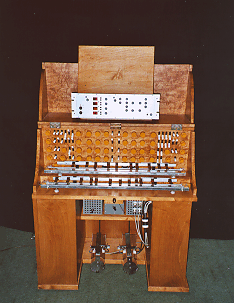
Fig. 1
(Fig. 1 shows the Trautonium model in the Technischen Museum Vienna. We built the electronics for this instrument, i.e. the manual electronics and the sound generation unit. In the upper section the 19 inch frame containing the electronics can be identified. It contains the manual electronics, the prototype of the subharmonic oscillator (A-113) and some A-100 modules (VCO, VCAs, Noise, Mixer, Filter) required for the Trautonium sound generation. The mechanical and structural parts (i.e. the wooden cabinet and the manuals) are built by Hauck Museumtechnik, Hassfurt (Germany).)
|
Oskar
Sala,
the German composer and physicist, has died
on Wednesday, February 27, 2002 at the age of 91 in Berlin. He was the inventor of the Mixtur Trautonium,
a novel
musical instrument that produced the sound effects for Alfred
Hitchcock's "The Birds" among others. Born
in the eastern German town of Greiz, Sala is known for developing and
mastering the trautonium, billed as the world's first electronic musical
instrument on its invention in 1929.
He performed with the Berlin Philharmonic several times, and the
instrument — a precursor to the synthesizer — was frequently used in
German ads in the 1940s and 1950s. The trautonium was most famously
employed to produce the bird calls in Hitchcock's 1963 film. Few people
realized the cacophonous calls on the film were produced electronically.
Sala
donated his original Mixtur-Trautonium to the German Museum for
Contemporary Technology in Bonn in 1995. |
Contents:
The Trautonium is an electronic musical instrument invented by Friedrich Trautwein in the thirties in Berlin, Germany, with enhancements made by Oskar Sala in the fifties which led to the well known Mixtur-Trautonium. The Trautonium can be divided into two logical sub-units: the control unit and the sound generation unit.
1. 1. The Control Unit (Manual)
The control unit of the Trautonium essentially consists of the manual and a foot controller with two associated switches. The Trautonium is modelled on the so-called "Bandmanual" of the Hellertion, invented by Hellberger and Lertes early in this century. But it uses a resistive wire - actually a nonconductive string wound round with a resistive wire (1). The string is stretched at a distance of some cm above a conductive metal plate (2). The isolated terminals (3) of the string are connected to a voltage source of some few Volts. A small pressure applied to the string with a finger causes a connection between the string and the plate. As a result a voltage depending upon the position of the finger appears at the plate.
Example: If a voltage of 3V is applied to the string terminals (i.e. left terminal = GND, right terminal = +3V) and the voltage applied to the plate is connected to the control input of a voltage controlled oscillator (VCO) one obtains a simple manual that enables control of the frequency of the VCO over about 3 octaves infinitely without steps.

Fig. 2
Additionally the plate is mounted so that it is movable around an axis (6) with two bearings (5) and can be moved some cm downwards. Two springs (4) mounted below the plate return it to its neutral position if the pressure is taken away.
The vertical position of the plate is used to control the loudness. In the neutral position the loudness is zero (no sound), and in the lowest position the loudness is at maximum. There are various possible technical methods of obtaining this information as a variable voltage (e.g. inductive, capacitive, resistive or opto-electronic sensors).
Example: If the voltage generated by the sensor (range 0...+5V) is connected to the control input of a voltage controlled amplifier (VCA) one obtains the desired loudness control.
Additionally the total loudness is controlled by a variable foot controller so that 2 serially connected VCAs are necessary to obtain the complete loudness control of the original Trautonium. The first VCA is controlled by the vertical position of the manual, the second by the foot controller.
Above the string a set of about 10...15 metallic spring tongues is mounted on a moveable shaft. The tongues are covered by thin leather so that they are non-conductive. The tongues are moveable on the shaft and are normally used to define certain musical intervals (e.g. C-E-G-C...) like keys on a keyboard. By moving the complete pole to the left or right the transposition of all tongues is changed simultaneously. The tongues can be used as dummy keys giving a visual indication of the correct intervals. But they also can be used like real keys, i.e. one presses the tongue with a finger so that the string touches the metal plate and one obtains certain tones (e.g. C-E-G) provided the tongues are adjusted accordingly. The tongues and the pole are not shown in fig. 1 for the sake of clarity. Oskar Sala e.g. uses the tongues for C,D,G and A in each octave.
In the photography showing the Oskar Sala's Mixtur-Trautonium these tongues (8) mounted on the common moveable shaft (9) are clearly visible. The other numbers in the photograph refer to the same details as in fig. 1 and text above. The bearings and the pivot cannot be seen in the photograph as they are hidden behind the cover.
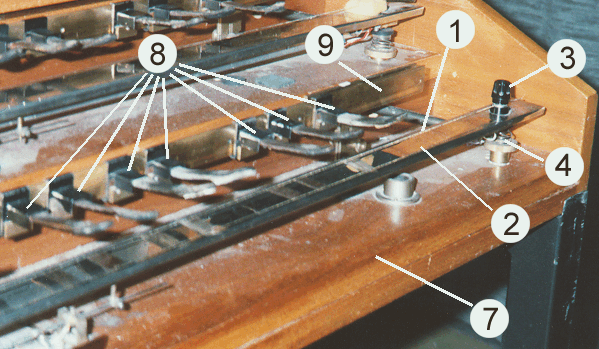
Fig. 3
To obtain a manual that can really be used by a musician for virtuoso playing some additional improvements are indispensable, e.g. felt shock-absorber, vibration dampers, light-weight but torsion-free construction, smooth and free-moving ball bearings (5) and much more.
The classic Trautonium (called the Telefunken-Trautonium) had one manual and one foot controller. In the Konzert-Trautonium and Oskar Sala's Mixtur-Trautonium two manuals and two foot controllers exist. Each of the manuals, which are approximately 70 cm (28 inches) long, have a range of about 3 ½ octaves.
The foot controllers of the Mixtur-Trautonium are extended by two switches which are controlled by lateral movement selecting 3 different sets of subharmonics (the so-called mixtures, see chapter 1.2) for each of the 2 manuals independently. These switches are visible in the photograph below showing one of the foot controllers of Oskar Sala's Mixtur-Trautonium.
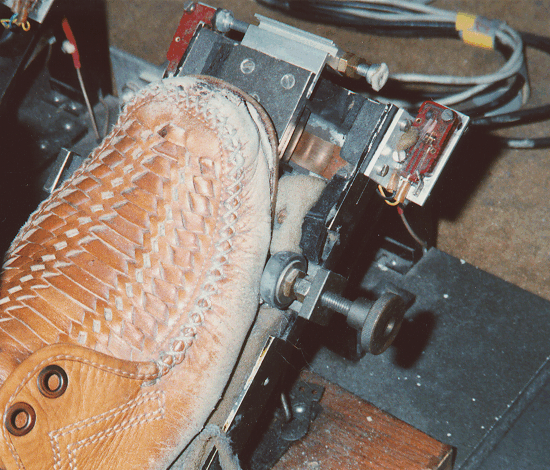
Fig. 4
Additionally a special liquid resistor designed by Oskar Sala uses the vertical movement of the manual to control the loudness of the Trautonium. It works as a variable capacitor with glycerine as the dielectric medium. The viscosity of the glycerine results in a very specific dynamic control and enables high resolution in the musically very important pianissimo range.
1.2. The Sound Generation Unit (Subharmonic Oscillator)
The sound generation of the first Trautonium was a sawtooth-like frequency generator. The frequency was controlled by the string manual. The output of the frequency generator was fed into two parallel resonant filters. The footpedal controlled the volume ratio of the output of the two filters. The resulting signal was weighted by the pressure sensor and further fed into a power amplifier connected to a speaker.
The special quality of the Trautonium from today's point of view was introduced by Oskar Sala with the Mixtur-Trautonium. In the Mixtur-Trautonium the frequency of a master oscillator is controlled by the string manual. Four independent frequency dividers generate 4 new frequencies - the so-called subharmonics - from this master frequency. The divisor for each subharmonic can be adjusted between 1 and 24 by four 24-position rotary switches. The subharmonics are the product of the master frequency and an integer number in the range of 1..24.
The maximum frequency of the master oscillator in the original Trautonium is about 4 kHz (quoting Sala: highest note C5 = 4186 Hz). As the range of the string manual is about 3 ½ octaves the lowest master frequency is about 400 Hz (quoting Sala: g1 = 392Hz). With the maximum divisor of 24 the lowest subharmonic frequency is about 16 Hz (392Hz : 24).
Each frequency of the 4 subharmonics is always an integer ratio of the master frequency. If you assume e.g. a master frequency of c4 the subharmonics are c3 (c4:2), f2 (c4:3), c2 (c4:4), as1 (c4:5), f1 (c4:6), d1 (c4:7), c1 (c4:8) and so on. These are notes from the minor chord progression c - as -f.
Note: In contrast to this the harmonics - i.e. the integer multiples of the master frequency - result in a major chord progression c-e-g. The subharmonic progression is the mirror image of the harmonic progression.
A combination of 4 subharmonics is called a mixture. In the Mixtur-Trautonium 3 different mixtures are available for each manual. The 3 mixtures are selected with the lateral operating switches mounted on the left and right side of the foot controller. For each of the 3 positions (left - middle - right) a separate mixture is available. Thus the subharmonic oscillator contains 12 frequency dividers after all.
The term subharmonic should not be taken at face value. The outputs of the frequency dividers are sawtooth-like waves rather than sine waves used in harmonic theory (Fourier theory). Each of the 4 sawtooth outputs has a rich harmonic spectrum as in the sawtooth waveform all even and odd harmonics are present.
Summary: The output signal of the subharmonic generator consists of 4 sawtooth-like waves - the so-called subharmonics. The frequencies of the subharmonics are integer ratios (1..24) derived from a common master frequency. Each subharmonic has a harmonic spectrum (i.e. "real" harmonics) containing all harmonics (even and odd).
The volume ratio between the oscillators is fixed for each of the three lateral pedal positions. In the first Trautonium the sum of the subharmonic signals is fed to two parallel resonant filters. The sound generation unit of the Mixtur-Trautonium contains some more units like noise generator, mixers, envelope generator and frequency shifter. All these devices already exist as modules in the Doepfer A-100 modular system and are therefore not described here.
Fig. 5 shows the Mixtur-Trautonium on which Oskar Sala used to play during the last years. It was a loan from the Deutsche Telecom where the device was built during some dissertations. The different function groups are easy to recognise.
In the lower section of the picture the two manuals
1 and 2 can be identified. On the manuals stands a distribution box 3. With this box the control signals coming from the manuals, foot controllers and foot switches can be adjusted and assigned to the sound generation units. E.g. the left sound generation unit (see below) can be controlled with the right or left manual.Above the manual a frame structure with 3 "floors" similar to the A-100 frame system is located. The two lower floors essentially contain the 2 identical subharmonic oscillators and the related units (Noise, VCAs). The 12 two-digit LED displays and the corresponding rotary switches for adjusting the frequency divisors
5 are clearly visible. The 12 displays and switches are arranged in 3 columns with 4 rows each. The left column corresponds to the mixture for the left foot position, the middle column for the middle position and the right column for the right position. The 4 controls for one foot position are located one below the other.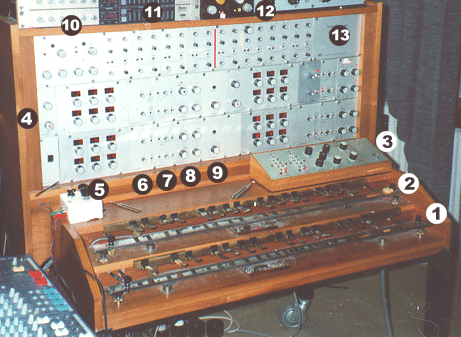
On the left side of each of the frequency divider units the frequency controls for the
master oscillator and an auxiliary oscillator (German: Neben-Oszillator) 4 are located.
The auxiliary oscillator is another sound source and its frequency can be adjusted
independent of the master oscillator's frequency so that vibrato or phasing type effects
can be obtained with the typical beat frequency.
On the right side of the frequency divider come the rectangle/sawtooth converters
The upper "floor" of the frame construction contains (from the left to the
right):
"Schlagwerk" (10), 4 formant filters for the lower manual (11), 4 formant
filters for the upper manual (12) and the filter distribution unit (13).
The "Schlagwerk" (10) contains two simple A/R envelope generators
(attack/release) that can be used in 2 different modes. In triggered mode (German:
getriggert) they work like a standard A/R envelope generator and are triggered by the
vertical movement of the corresponding manual. As soon as the manual reaches a certain
position the "Schlagwerk" is triggered. This works like the Gate signal in the
A-100 system.
In free running mode (German: freilaufend) the envelope generators change into a LFO (low
frequency oscillator) with adjustable frequency. In this case the position of the manual
has no effect on the "Schlagwerk", i.e. no reset is triggered in free running
mode. The control voltages of the 2 "Schlagwerk" units can be used to control
the channel amplifiers. In the "Schlagwerk"'s triggered mode this is very
similar to the VCA control used in most analog synthesizers, i.e. an envelope generator
triggered by a Gate controls an VCA.
Each of the 8 formant filters (11,12) consists of a band pass and a low pass. A toggle
switch determines if the filter is used as band pass or low pass. Frequency and resonance
of band pass and low pass can be adjusted independently as well as input and output level.
At higher settings of the level controls clipping occurs to obtain distortion effects
(German: Trompeten-Effekt, i.e. trumpet-like tonality).
The filters are inserted between the channel amplifiers
2. The Realization within the A-100 Modular System
The realization of the Trautonium within the A-100 is apparent as the Trautonium-specific units Manual A-198, Subharmonic Oscillator A-113 and Filter A-104 seamlessly fit into the A-100 idea. A lot of circuits required to complete the Trautonium already exist as A-100 modules - like master oscillator (VCO), mixers, noise, voltage controlled amplifiers (VCA), envelope generators, low frequency oscillators (LFO), frequency shifter and many more. The Trautonium manual A-198 can be treated as a new control voltage source (like the MIDI-to-CV interfaces A-190-3 or A-190-4, the Sequencer A-155, the Theremin A-178, the Foot controller A-177 or others) to control the pitch of the oscillators (e.g. A-111-3) and the subharmonic generator A-113. On the other hand the subharmonic generator may be treated as a new sound source like VCO, Sampler, Noise or other sound sources. But it is not imperative to control the subharmonic generator from the Trautonium manual. A MIDI-to-CV interface, sequencer, Theremin or any other control voltage source could do this job as well.
The new Trautonium modules should be treated the same as all the other modules of the A-100. Of course one could build up a replica of the original Trautonium from the new modules A-198, A-113, A-104 and some other standard modules (VCA, Mixer, and so on) . But you could just as easily control the subharmonic generator A-113 from a Theremin A-178 or MIDI interface (e.g. A-190-3 or A-190-4) and modify the sound e.g. with one of the A-100 filters or other sound processing modules - or even use the Trautonium Manual A-198 to control a "normal" synthesizer voice (VCO-VCF-VCA-ADSR) possibly with the aid of the quantizer A-156 to obtain exact semitones.
2.1. The Control Unit: Trautonium Manual A-198
For our design of the Trautonium Manual A-198 - that can be treated as a ribbon controller too - we simplified the mechanically very complicated and expensive construction of the original Trautonium manual and realized a more simple but - from our point of view - equivalent solution. Instead of the string with the resistive wire we use a position sensor (about 50 cm length) that is normally used for industrial applications. This reacts very sensible. Only a very small pressure is necessary to trigger the position sensor. Below this position sensor a pressure sensor (conductive rubber) is located. This replaces the large-scale construction of the metal plate movable around an axis. Compared to the original Trautonium manual this solution has some advantages: very sensible position sensor (no movement of the string over about 10 mm required), no complicated and susceptible construction of the movable metal plate, more simple and nearly maintenance-free construction.

We know that we went away a little bit from the original construction and Oskar Sala and the builders of his instrument may forgive us for this sacrilege. But a 100% replica of the Trautonium manual would be very complicated and much more expensive than our solution. We are subject to economic and legal terms and would e.g. not be able to offer the legal warranty as the construction of the original Trautonium manual would not survive the warranty period. Even Mr Sala very often carried out repairs at the manual before he began a concert. All these occurrences would be warranty cases from the economical/legal point of view and this is why we decided not to built a 100% replica of the Trautonium manual. If you are interested to built a 100% copy of the manual yourself you could find some information in the internet. As we built some prototypes too maybe we could help too. Some of the mechanical parts required (small ball bearings with supports, metal axis, springs, dampers and so on) are e.g. available from the German mail-order firm Conrad (www.conrad.de). A problem might be the string that has to be winded round with resistance wire ("constantan"). You could use a standard guitar plastic string and wind the wire around the string yourself. But you may even ask a guitar string manufacturer to do this job for you. Finally you have to polish the string very carefully with sandpaper so that the string gets a smooth surface. Pay attention not to smooth the string too much. The resistance wire is not allowed to be interrupted.
The Trautonium-Manual is available as module A-198 as part of the analog modular system A-100.
2.2. The Sound Generation Unit: Subharmonic Generator A-113
The development of the subharmonic generator is finished and the new module A-113 is now available.
The design of the A-113 is very close to the subharmonic generator of the Mixtur-Trautonium of Oskar Sala. At this point we would like to thank Oskar Sala and Prof. Hans-Joerg Borowicz, Berlin for the kind assistance during the development of the Trautonium modules.For the adjustment of the 4 subharmonics, i.e. the 4 divisors for the frequency dividers, up/down buttons are used rather than the rotary switches in the original Trautonium. The divisors are displayed with four 2-character LED displays. The adjustment via up/down buttons instead of rotary switches has the advantage that all subharmonic settings can be stored in presets and later edited, starting from the values stored in the presets.
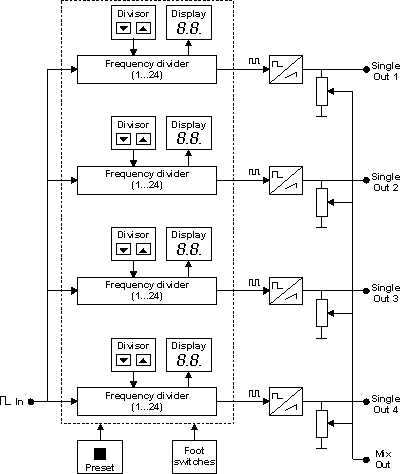
Fig. 6
The A-113 features 2 control inputs (Foot Ctr. 1 and 2) to switch between the 3 mixtures for the 3 foot switch positions (left - middle - right) controlled by the switches left and right of the foot controllers. Normally the foot switch signals are connected to these inputs. But mixture switching could be controlled by any other control source as well (e.g. MIDI controller via MIDI interface or sequencer gate output). The current mixture settings are displayed in the four LED displays. The decimal points of the displays are used to indicate the current foot switch setting resp. mixture selection:
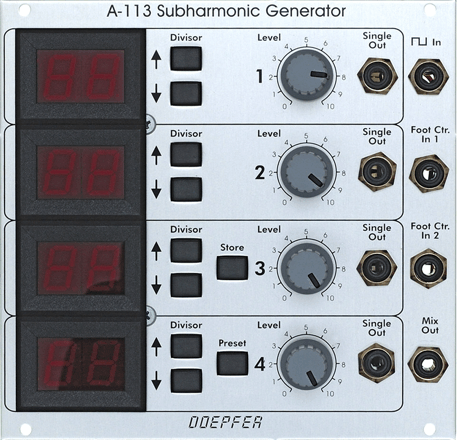
Fig. 7
The current mixture setting - i.e. the 4 divisors for left, middle and right foot position - can be stored as a preset. Each preset consists of the 3x4 = 12 divisor values. 50 presets are available within the module. A new preset is selected with the lower up/down button pair while the preset button to the right of these is pressed. While this button is pressed the lower display shows the current preset no. (01...50). The upper three displays will be off or probably show "P" or "Pr" to indicate the preset mode. As soon as the preset button is released the normal mode is activated and the current mixture is displayed. If you want to know only the current preset number, you simply have to press the preset button to see it in the lower display. For details please refer to the A-113 user's manual.
The output waveforms of the A-113 are sawtooth - like the subharmonic oscillator of the original Trautonium. The four waveforms are available as four single outputs as well as a mixed output with adjustable level for each of the subharmonics. The master oscillator is not an integral part of the A-113. Instead of this the module has an input for an external master oscillator. Normally the rectangle output of a VCO (e.g. A-110) is connected to this input. The frequency divider/sawtooth converter of the A-113 use the same range as the original Trautonium i.e. about 20Hz...5kHz.

Fig. 8
The above picture shows the Trautonium electronics built for the Technische Museum Vienna. It contains the prototype of the subharmonic oscillator (A-113) and some A-100 modules (VCO, VCA, Noise, Mixer, Filter) required for the Trautonium's sound generation.
On the left there are two 1/4" stereo jack sockets for connection to the manual (string and manual position sensor). The manual electronics are located behind the jack sockets. To the right of the sockets come the master oscillator (a modified A-110, with only octave rotary switch and tune control available) and the subharmonic oscillator with the four 2-digit displays. In this prototype the preset feature and the mixture switching with the foot switches is still missing. To the right of the subharmonic oscillator are the auxiliary oscillator (A-110), Noise (A-118), Mixer (A-138b), 2 Filters (2 x A-121) and VCA (A-131). These modules are a little bit modified (no jack sockets and not all controls available) and internally connected (no external patches). At the left side of the panel the audio output is located.
The Trautonium model at the Technische Museum Vienna can be played with some restrictions mentioned above (e.g. no foot controls). But the mechanics of the manuals still has to be improved as the available prototype does not yet meet the standards of a playable musical instrument especially with regard to smoothness, repetition, mechanical noise, damping and much more.
You will find price for the subharmonic oscillator A-113 in the price list.
Filter A-104The reproduction of the 4-fold Trautonium filter with A-100 modules would be possible with 4 multimode filters A-121 and a mixer A-138a/b. But we decided to develop a separate Trautonium filter A-104 as this could be realized much cheaper than four A-121 and one A-138 as the voltage control of the filter parameters (frequency, resonance) is not necessary for the Trautonium filter. Even the patching will be much easier. If one want to have voltage control of all filter parameters of course four A-121 and a A-138 can be used.
Module A-104 has the same features as the filter section of the original Trautonium: 4 filters in parallel, each filter can be switched to band pass or low pass or off. The filter parameters frequency, resonance and amplitude are adjustable manually for each of the four sub-filters (no voltage control).
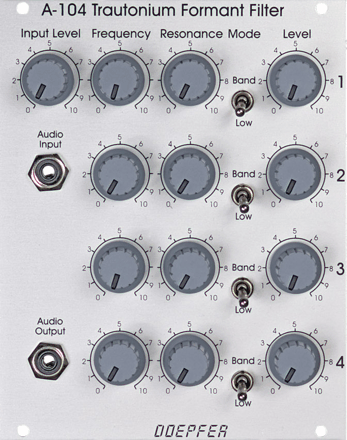
Front view of the Trautonium Filter A-104
The Trautonium filter is available as module A-104. The current price can be found in the price list.
To reproduce the complete sound generation of the Trautonium some additional modules are required. The following illustration shows the sound generation principle of the original trautonium with the corresponding A-100 modules in parentheses.
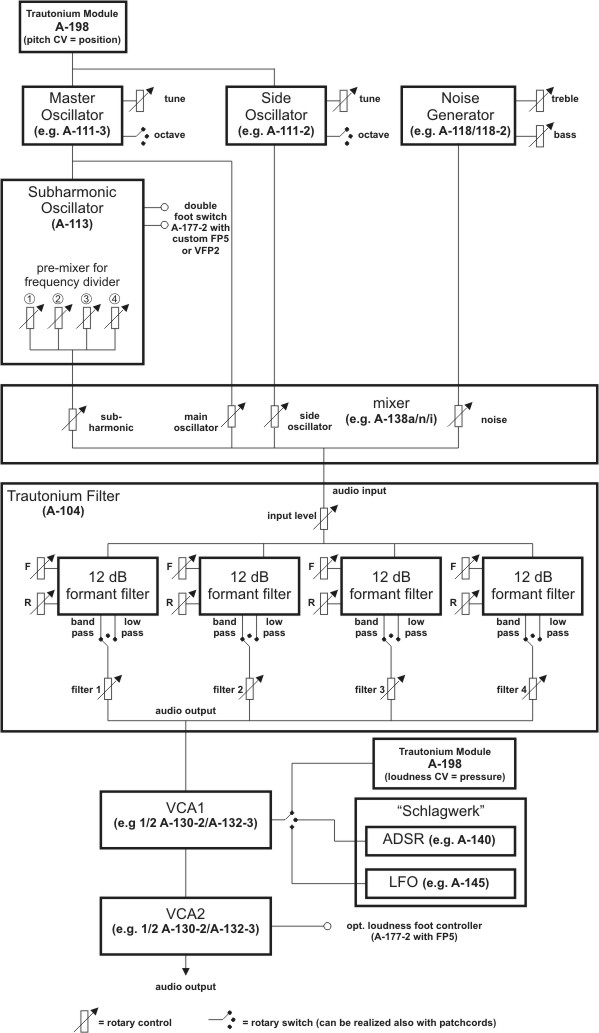
Fig 9. :Sound generation of the original Trautonium (schematically)
Additional remarks:
The picture below shows a suggestion for a Trautonium replica and how the
required modules could be are arranged in an A-100 frame. It contains also some
auxiliary modules (like A-185-2 or A-180-2)
as well as some modules that offer functions which were used very often by Mr. Sala
in combination with the Trautonium (e.g. Frequency-Shifter A-126-2 or an audio delay),
or which make generally sense in combination with the Trautonium (e.g. Quantizer A-156 ,
a voltage controlled filter like A-121-2 or the ringmodulator/S&H
module A-184-1).
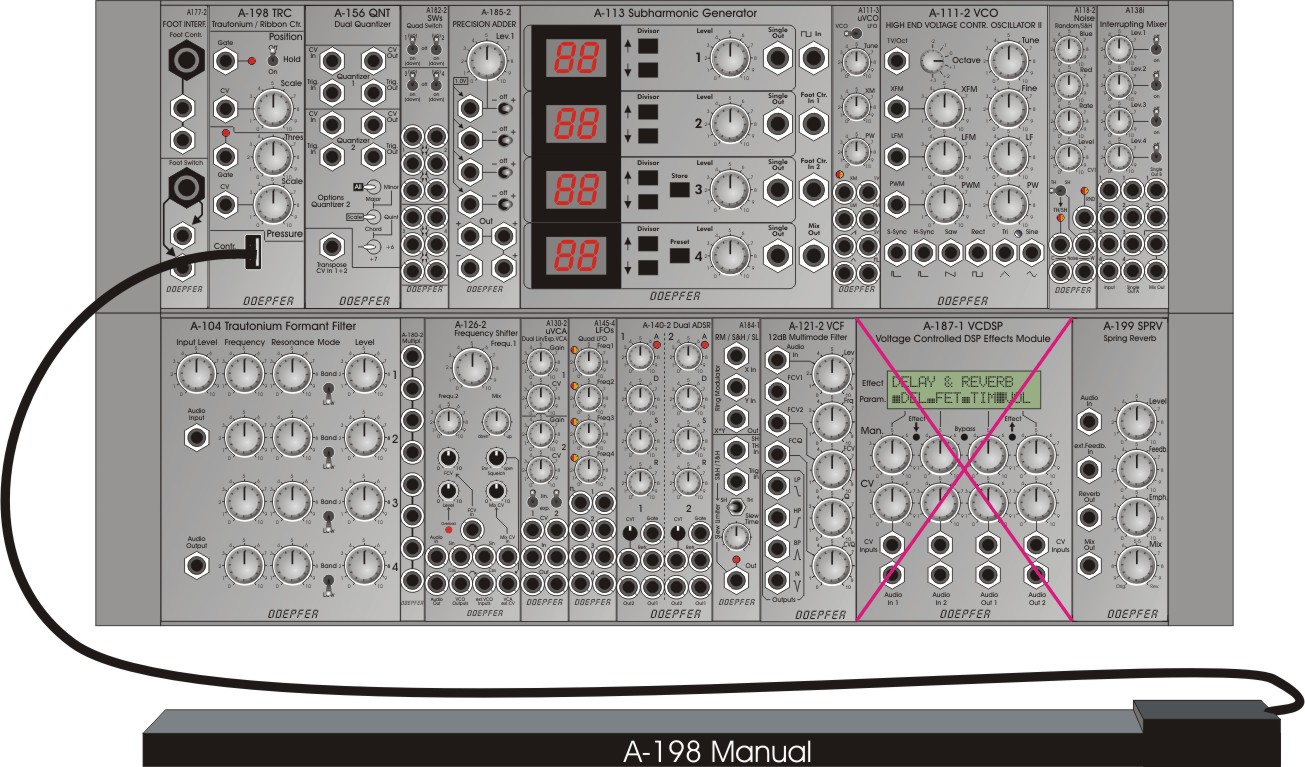
Remarks:
Detailed list for modules in the above example:
The prices for all articles can be found the price list.
All specifications, prices and dates of availability are without obligation, not binding and subject to change.